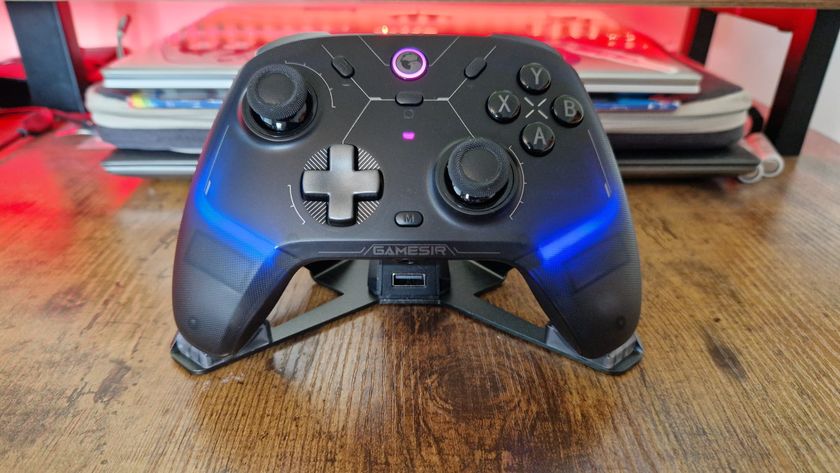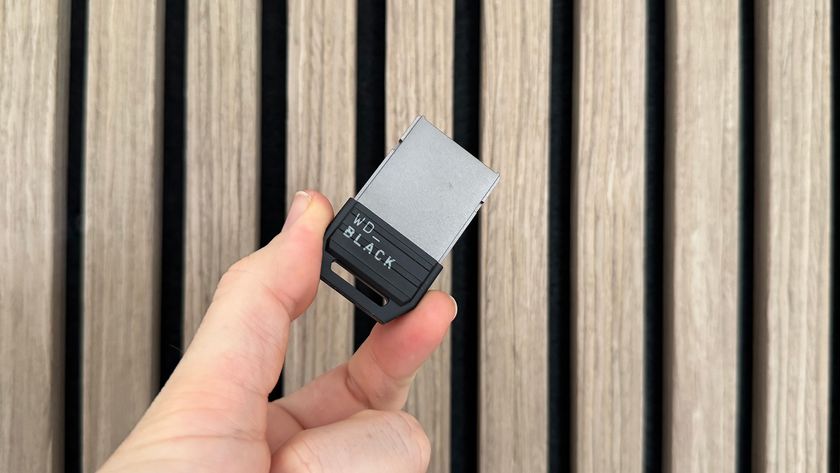12DOVE Verdict
The Jsaux FlipGo is a fantastic portable dual monitor for anyone looking to boost productivity, and it handles games nicely too. That said, it’s probably worth investing in this one if you need a secondary set of screens rather than a bona fide mobile display for gaming on-the-go.
Pros
- +
Dual QHD screens
- +
Plenty of ports
- +
Single cable connectivity via USB-C
Cons
- -
No built-in battery
- -
More for productivity than gaming
Why you can trust 12DOVE
When I first heard that the Jsaux FlipGo was a thing, I was immediately worried that the Steam Deck accessory maker was stepping outside its comfort zone. Even screen makers don’t always strike the right balance when making portable monitors, so this stacked dual display setup felt a bit too ambitious for my liking. However, I actually ended up vibing with what the setup has to offer during testing, even if some touches feel a bit rough around the edges.
Starting at $399 (roughly £322), the Jsaux FlipGo isn’t remotely a budget portable monitor solution. At least, it isn’t what I’d recommend if you’re just looking to extend your gaming handheld screen, as there are plenty of other options out there for that. What this package does deliver is maximizing vertical productivity space without much clutter, meaning it could make the perfect streaming setup addon or an extension to your collapsible gaming laptop battle station.
During my time with the FlipGo, I’ve been coming up with different use cases. I’m not sure why Jsaux’s first screen isn’t designed to pair with something like the Steam Deck OLED, but I do see how offering a stacked display could set the accessory maker apart from its competition. That said, there are a few missing perks from the overall package that would place the dual monitor in pole position, and some players may end up looking elsewhere as a result.
Specs


The FlipGo model I’ve been testing is the 13.5-inch ‘Pro’ model which boasts 2256 x 1504 dual panels running at 60Hz. Comparatively, the only difference between this version and the standard edition is DisplayLink support and an Ultraview mode, both features that’ll help wield command over output configurations.
To gain features like touchscreen support, you’ll have to opt for a specific model with the right panel. You’ll end up with the same specs, and I honestly would have preferred if touch support was included as a base feature. Still, at least it’s an option you can go for if you’d rather use your fingers to navigate menus, whereas desktop users can stick with the standard version.
| Specs | Model tested | Also available |
|---|---|---|
| Price | From | From |
| Screen size | 16-inch | 13.5-inch |
| Screen type | IPS (touchscreen also available) | IPS (touchscreen also available) |
| Resolution | 2560 x 1600 | 2256 x 1504 |
| Brightness | 500 nits | 400 nits |
| Viewing angle | 170° / 170° | 170° / 170° |
| Aspect ratio | 16:10 | 3:2 |
| Contrast ratio | 1200:1 | 1500:1 |
| Inputs | 3 x USB-C (60W PowerDelivery, DisplayPort), 2 x USB-A, 1 x mini HDMI | 3 x USB-C (60W PowerDelivery, DisplayPort), 2 x USB-A, 1 x mini HDMI |
| Built-in battery | No | No |
| Weight | 1.78kg | 1.1kg |
As for ports, the FlipGo somewhat spoils us with three USB-C ports, a double serving of USB-A, and even Mini HDMI. The former USB-C ports are labeled up with specific functions, as one will dish out a DisplayPort signal while the others are designed to handle peripherals and receive power. Essentially, the configuration will allow for hooking devices up via a single cable, rather than using multiple wires or an additional Steam Deck dock.
Sadly, the FlipGo doesn’t come with a built-in battery, so you’ll need to rely on a power bank if you want to truly go off-grid with it. The fact it uses USB-C for power means you will be able to pair it with something like the Jsaux 20000mAh, with its 65W output matching the adapter that comes with the set. I’d personally aim for a higher wattage to support anything that’s also connected, but your setup needs may vary.
Design



Saying that the FlipGo looks like two laptop screens sandwiched together feels uninspired, but that is exactly what Jsaux has conjured up. At a glance, it almost looks like my 2021 Asus TUF Dash F15, but it does come with an aggressively orange cover that’ll prevent any device mixups. Removing the protective pad reveals an aluminum body paired with plastic bezels, a combination that feels rigid and robust without adding too much heft.
I’m not sure whether Jsaux is planning on providing additional colorways, but permanently ditching the included might not be the best idea. There’s a specific section of the monitor’s hinge where a ribbon cable is just about visible, and I suspect the case plays a part in shielding that. On top of that, Jsaux has added a magnetic strip to one of the sides to bolster additional accessory support, and I feel like it’s a little janky-looking without anything attached.
I even managed to get in a few hours using my PC Engine Mini with the screen, and I could see myself using it for a camping trip.
Speaking of which, the FlipGo is designed to pair with multiple accessories, including a magnetic adjustable stand, VESA mount, and folio covers. All of these options provide Jsaux’s screen with a means to stand, as you’d otherwise have to open it up like a laptop with the button panel lying flat. I’ve been using the pedestal stand for this review, and that magnetic strip boosts the experience of using add-ons thanks to its exceptional strength. I’m very much on board with being able to snap things into place on the fly, and I can imagine using different methods depending on where I’m working.
As for the inputs and buttons, you’ll find everything you’ll need spread across the left and right sides. Unfortunately, the ports are accompanied by a horrible rocker-style menu switch that I haven't had to deal with since working in a TV store in the early 2010s. The idea is that you’re meant to rock back and forth to navigate and push inwards to select, and the whole experience just feels nasty on the thumbs. I thankfully didn’t feel much need to head into the system menu much since there’s an additional toggle for input selection, but I’m horrified that the switch type is still a thing in 2024.
Features
Slapping two laptop screens together is all fine and well, but making the pairing useful requires reliable features. This is something Jsuax has clearly thought hard about when creating the FlipGo, resulting in a setup that can accommodate various display preferences. I would argue it’s a portable monitor that leans more towards productivity than gaming, so that’s worth keeping in mind when considering the following perks.
One of the things I love most about the FlipGo is its single-cable approach to connectivity. It’s actually something that’s included with many of the best gaming monitors to arrive in 2024, with the likes of the Philips Evnia 42M2N8900 and even the cheaper KTC G27P6 providing integrated USB-C hubs for power and display input. Naturally, the first thing I itch to do with this kind of setup is hook up my Steam Deck, but it’s a bigger boon for those of you with full-blown laptop setups paired with plenty of peripherals.
The fact that the FlipGo also wields Mini HDMI cable support is pretty spectacular, as it effectively means you can hook up a wider variety of devices. I’d hesitate to refer to Jsaux’s screen as a PS5 monitor since it’ll only use one of the panels, but the option is still there if you happen to own a new-gen console. I even managed to get in a few hours using my PC Engine Mini with the screen, and I could see myself using it for a camping trip.
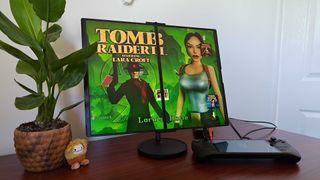
The rest of the heavy lifting in the FlipGo features department is performed by the screen’s scaling abilities. By toggling the left-hand side button, you’ll be able to choose whether your connected device spreads itself across both displays, splits into separate desktops, or uses a single panel. Practical uses for this include having an additional two screens for your laptop, something that could be handy if you want to play games and still have Discord to hand when on the go.
As for me, I decided to make a real-life Tiktok brain rot setup, complete with some Subway Surfers action and classic Family Guy episodes at the bottom. Yes, this is incredibly silly, but it does demonstrate the fact you can use a handheld to pull off this sort of multitasking using the FlipGo. The whole point is that if you’re using Windows or Linux, you’ll be able to dial things in the same way as if you had two full-blown monitors to hand.
Performance
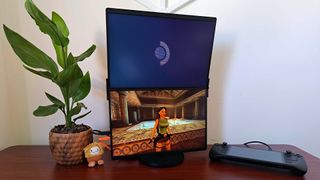
Visually, the Jsaux FlipGo holds up really well, providing respectable contrast levels for a dual IPS setup. Brightness levels feel up to par too, despite the fact we’re talking about two panels running on 65W. I even managed to get some time in with Tomb Raider Remastered Trilogy next to a large window during the day, and both screens punched through without losing vibrance.
It’s important to hammer home that we are talking about 60Hz screens here, and the 3:2 double-stacked layout is begging to handle apps over games. I’m planning on properly getting back into Twitch streaming this year, and while I tend to prefer single monitor setups these days, I can see myself pitching up a FlipGo whenever the need arises. Each display’s QHD resolution makes text nice and viewable at a glance, not to mention there’s a whole other panel there for OBS bits and bobs.
One quirk I did come across during use relates to using the Steam Deck, specifically in gaming mode. For whatever reason, the top display has trouble syncing the Deck’s output, leading it to blink on and off. Toggling it to appear on the bottom screen seems to fix the issue, but it does mean you’ll have to use desktop mode if you’d prefer to play on the upper display.
Should you buy the Jsaux FlipGo?
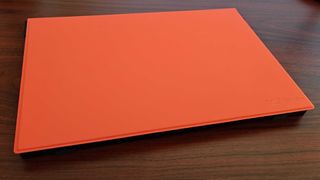
Ultimately, the Jsaux FlipGo caters to portable dual monitor productivity over on-the-go gaming, but still successfully pulls off both endeavors. While there are portable screens that’ll provide you with a built-in battery and faster refresh rate, having two panels at your disposal is arguably an acceptable trade-off.
At its current price, the FlipGo isn’t particularly budget-friendly, so that’s also worth keeping in mind if you’re trying to keep costs low. That said, most other options at Amazon right now aren’t much cheaper, and we are talking about two displays in one compact package.
How I tested the Jsaux FlipGo
For around a month, I used the Jsaux FlipGo as both a secondary screen and a way to play games on the go. During that time I used the dual display to run apps like Discord and Spotify with my laptop and PC, while also using it to enlarge playspace with the Steam Deck for games like Tomb Raider Remastered Trilogy.
For more information on how we test monitors and other gadgets, check out our 12DOVE Hardware Policy for a deeper dive.
Looking for more screens? Swing by the best 4K monitor for gaming and best PS5 monitors for specific options. If you aren't looking for something remotely portable, then you might want to take a peek at the best gaming TVs instead.

I’ve been messing around with PCs, video game consoles, and tech since before I could speak. Don’t get me wrong, I kickstarted my relationship with technology by jamming a Hot Wheels double-decker bus into my parent’s VCR, but we all have to start somewhere. I even somehow managed to become a walking, talking buyer’s guide at my teenage supermarket job, which helped me accept my career fate. So, rather than try to realise my musician dreams, or see out my University degree, I started running my own retro pop culture site and writing about video games and tech for the likes of TechRadar, The Daily Star, and the BBC before eventually ending up with a job covering graphics card shenanigans at PCGamesN. Now, I’m your friendly neighbourhood Hardware Editor at GamesRadar, and it’s my job to make sure you can kick butt in all your favourite games using the best gaming hardware, whether you’re a sucker for handhelds like the Steam Deck and Nintendo Switch or a hardcore gaming PC enthusiast.
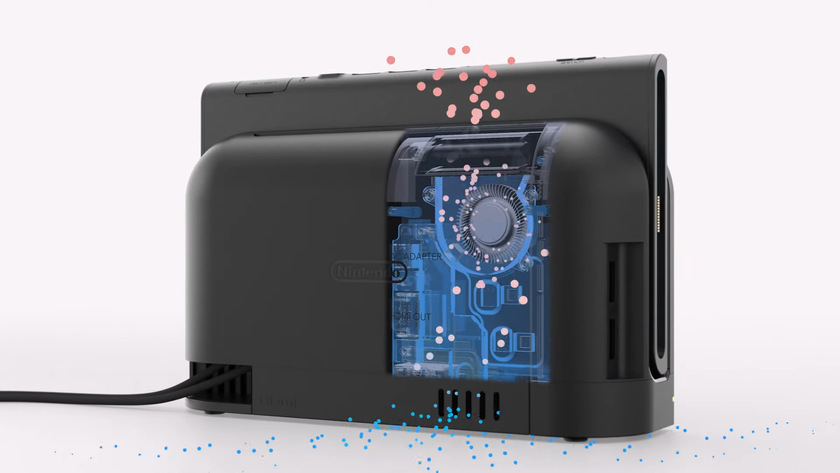
Nintendo says the Switch 2 "isn't simply an improved Nintendo Switch, we redesigned the system from the ground up," and after 8 years, I'd sure hope so
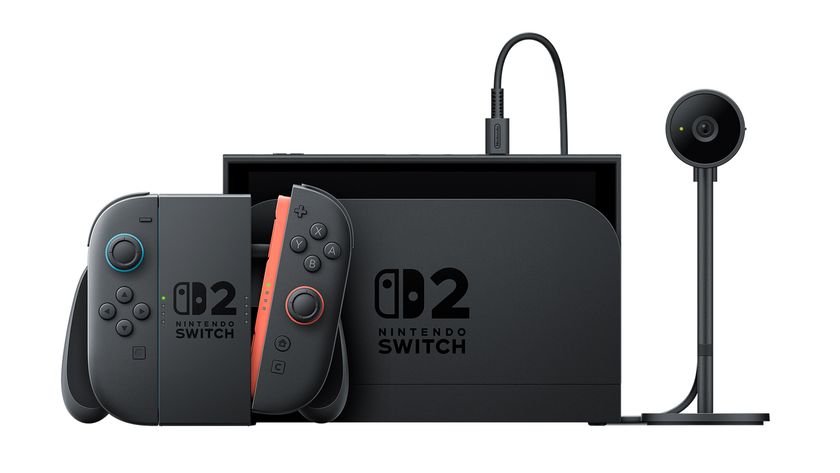
Japan's "multi-language" Switch 2 costs 20,000 more yen, or $130 more dollars, than the Japanese-only version

Elden Ring is getting a fancy new name on Switch, new weapons and armor, and new horse clothes on all platforms


